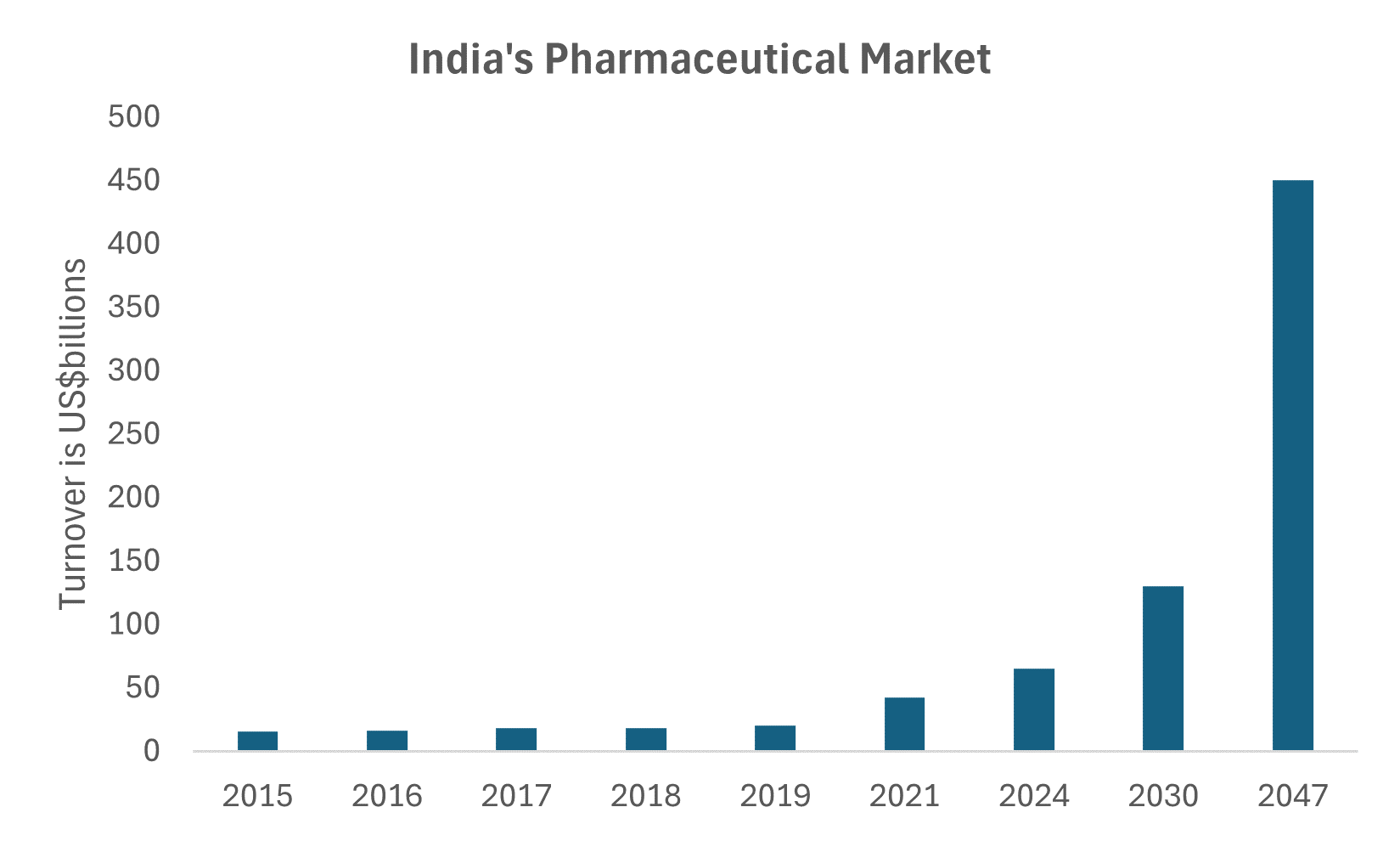Not all Megatrends are listed on the NYSE
When considering the next major investment opportunity, many investors naturally gravitate towards sectors such as AI, robotics, green technology, and renewable energy, all of which hold substantial potential for long-term advancements. However, other often overlooked industries are also poised for rapid growth and development — one notable example being India’s pharmaceutical (pharma) industry.
India’s pharma industry and the trajectory of this market
Presently, India plays a major role in the manufacturing and global export of pharma products. Some key insights into the current scale and significance of the industry:
India accounts for 60% of global vaccine production
India is the largest provider of generic medicines globally, occupying a 20% share of global supply by volume
India has the highest number of US-FDA-compliant pharma plants outside of the US. India has around 650 plants, constituting a quarter of all USFDA-approved facilities outside of the US.
India is increasingly being referred to as the “pharmacy of the world”
Source: Invest India – National Investment Promotion and Facilitation Agency of India
The
Indian pharma market is expected to reach USD$65bn by 2024 and double to USD$130bn
by 2030 (a CAGR of ~20% for the next 6 years). For context, other explosive
areas like the renewable energy market and the Fintech industry are expected to
grow at a CAGR of 17% for the next 5 years (Source: Grand View Research – Renewable Energy Market
2024) EY Parthenon suggests that the industry could
grow to USD$450bn by 2047, highlighting the exponential growth potential, and
like many industries the opportunities seem structural rather than tactical.

Source: Statista 2024, EY Parthenon
This growth trajectory is driven by:
- Domestic expansion, which is supported by the nation’s economic/wealth growth, heightened adoption of healthcare services, as well as significant government initiatives (PLI schemes, employment/training initiatives, and research schemes).
- Rise in exports to cater to an exponentially growing global demand. India currently exports to 200 countries.
- India’s low-cost advantage, significant pool of labour, and increasingly competitive nature in value-added industries.
- India is committed to achieving economies of scale for exports and reducing its reliance on imports, particularly for active pharmaceutical ingredients (APIs). The country's drug production costs are 40-70% lower, and labour costs are on average 60-70% less than those in developed nations. (Source: IBEF).
Why the industry has done well and why it will continue to expand rapidly
Over the past decade, India has worked its way to become one of the most dominant global suppliers of pharmaceutical products. This trend is set to grow exponentially as India is at the forefront of the “China+1” opportunity, competing effectively with other offshore contenders.
Manufacturing and managing the entire supply chain are critical in the pharmaceutical sector, and throughout the years India has solidified its strength in building a robust infrastructure and supply chain capabilities. This robust foundation enables India to produce pharmaceutical products at scale while maintaining high-quality standards. According to a McKinsey report, Indian USFDA facilities are of higher quality than the global average – having a lower number of Official Action Indicated (OAI), which means fewer regulatory/administrative actions recommended compared with international peers.
In recent years, various emerging trends such as pricing fluctuations, technological advancements, sustainability initiatives, the shift towards personalized and next-generation therapies, and novel healthcare delivery models have introduced complexities to manufacturing and supply chain operations. These trends act as significant catalysts, necessitating a re-evaluation of priorities and essential transformations within the manufacturing sector, positioning India as a primary beneficiary.
India’s extensive penetration of international markets is supported by its regulatory expertise and ability to meet stringent mandates and compliance standards. The Indian pharmaceutical industry also benefits from cost competitiveness, driven by lower labour costs, economies of scale, adoption of new technologies, automation, and efficient manufacturing processes. This cost advantage enables Indian pharmaceutical firms to offer competitively priced products both domestically and globally.
With all the necessary building blocks in place, India’s pharmaceutical industry is well-positioned for the next phase in dominating global production. Drawing parallels to the success of the Indian IT sector, the pharmaceutical market is set to become a cornerstone of India's broader economic narrative in the years to come.
Source: EY Report “Pharma and healthcare for India@100: a century of change on the horizon”
How to access this thematic
Despite being a global powerhouse, India’s pharma industry occupies only a small portion of the Indian stock market (roughly 4-5%), which means that investors have limited ways to access this colossal growth story in a substantial way. Additionally, investors outside of India also require a Foreign Portfolio Investment (FPI) licence to buy stocks listed on the National Stock Exchange of India (NSE) or the Bombay Stock Exchange (BSE). This meant that there are currently two viable methods and one less viable way for investors to gain access to this narrative in a meaningful way.
1) American Depositary Receipts (ADR) of an Indian pharmaceutical company
An example of an ADR available for investors to purchase is Dr Reddy’s, which is an ADR traded on the New York Stock Exchange (NYSE) under the ticker “RDY”. Dr Reddy’s Laboratories is an Indian multinational pharma company based in Hyderabad that manufactures and markets various pharma products on a global scale. Their products/services include generic medicines, pharma services and Active Pharmaceutical Ingredient (API).
2) Active India Funds
Another avenue for investors to gain exposure to the Indian pharmaceutical market is through actively managed India-only funds that have a strategic overweight in the sector, featuring generic drug manufacturers building a global footprint such as Sun Pharma, Cipla, Divis Laboratories, Aurobindo Pharma and Marksans Pharma. Given the sector's secular growth potential, several active India funds are able to capitalise earlier on this trend. Investors can identify these funds by examining their underlying industry composition. This approach also allows investors to participate in these businesses at an earlier stage in their growth cycle, before their market capitalizations fully reflect their global scale.
3) Global-listed healthcare companies with exposure to India’s healthcare market
An example of a global-listed company with such exposure is Pfizer. However, this method provides only a diluted exposure to India’s pharma segment (diluted by exposure relative to other markets). It doesn't capture the opportunity of India’s pharma industry winning market share globally from diversification of supply chains, exporting excellence, scale economics and cost advantage.
5 topics
1 stock mentioned

